Team:TUDelft/Research Proposal
From 2009.igem.org
(→Module 2: Self Destructive Plasmid) |
(→Constructing the Self Destructive plasmid) |
||
| Line 145: | Line 145: | ||
The tetR promoter which controls the GFP-LVA transcription is repressed by TetR. Therefore the SDP should contain a tetR gene as well in order to control GFP-LVA transcription. | The tetR promoter which controls the GFP-LVA transcription is repressed by TetR. Therefore the SDP should contain a tetR gene as well in order to control GFP-LVA transcription. | ||
The I-SceI restriction site and TetR generator are cloned into a high copy BioBrick assembly plasmid.<br> | The I-SceI restriction site and TetR generator are cloned into a high copy BioBrick assembly plasmid.<br> | ||
| - | [[Image:endonuclease_tetRProm_ISceI]]<br> | + | [[Image:endonuclease_tetRProm_ISceI.jpg]]<br> |
'''Figure 10: assembly of endonuclease, tetR promoter and I-SceI restriction site'''<br> | '''Figure 10: assembly of endonuclease, tetR promoter and I-SceI restriction site'''<br> | ||
At this point all the basic parts of the construct are built. In order to construct the SDP these parts should be reassembled. The I-SceI generator(I-Sce-I gene under control of a Lac promoter) is assembled with tetR promoter and I-SceI restriction site and cloned into a high copy BioBrick assembly plasmid.<br> | At this point all the basic parts of the construct are built. In order to construct the SDP these parts should be reassembled. The I-SceI generator(I-Sce-I gene under control of a Lac promoter) is assembled with tetR promoter and I-SceI restriction site and cloned into a high copy BioBrick assembly plasmid.<br> | ||
| Line 154: | Line 154: | ||
'''Figure 12: Final assembly of the SDP.'''<br> | '''Figure 12: Final assembly of the SDP.'''<br> | ||
At this point all the constructed biobricks are assembled together in order to construct the final construct, the Self Destructive Plasmid. | At this point all the constructed biobricks are assembled together in order to construct the final construct, the Self Destructive Plasmid. | ||
| + | |||
===Checking the Self Destructive Plasmid=== | ===Checking the Self Destructive Plasmid=== | ||
In order to check the activity of SDP some experiments should be done. | In order to check the activity of SDP some experiments should be done. | ||
Revision as of 11:58, 4 August 2009
Research Proposal
Contents |
Module 1: delay device
Delayed expression genetic circuit: This kind of circuit has the ability to integrate signals and trigger events after a delay from the initial detection event. There are two approaches to construct a time delay genetic circuit, these are:
- “protein-based” transcriptional regulators
- “RNA-based” posttranscriptional regulators[1]
Based on different literature, we had four different configurations for the time delay genetic circuit. Of the four approaches, two are protein-based and other two are RNA-based.
Positive feedforward
Based on the book of Uri Alon[2] and the project requirements, the next scheme can be proposed: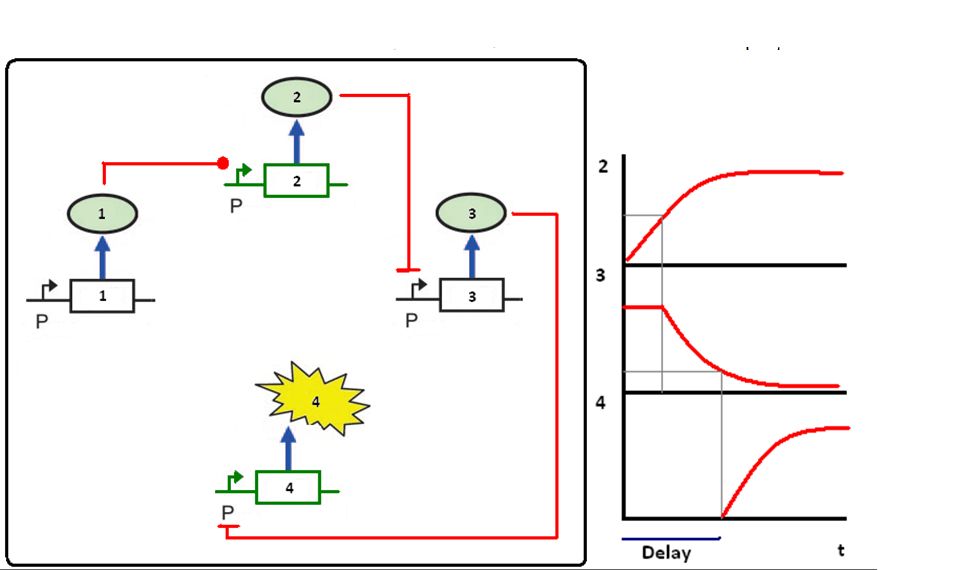
Figure 1: Genes 1 and 3 are present in the cell and they are produced all the time (black). Genes 2 and 4 (green) are in the self destructive plasmid (SDP).
Description
Protein 1 starts the circuit activating the promoter of gene 2, for proof of concept gene 1 can be changed for a signal molecule. The concentration of protein 2 will increase and achieve the threshold concentration to induce gene 3. As the concentration of protein 3 increases, the induction of gene 4 (restriction enzyme or fluorescent protein) starts.
Parameters
In order to make a longer or shorter delay the protein production and degradation rates have to be considered. For the former, we can “play” with the ribosome binding site (RBS) and promoter strength. The degradation can be controlled by protein stability, induction of degradation and up-down regulation of degradation enzymes.
Biobricks
- new RBS
- new transcriptional factors with different stabilities
- new promoters with different strengths
Take into account
- There are many of biobricks like 1 and 3 in the registry
- Positive feed is always related to leaking problems
- Time frame
- Change LVA tag to decrease degradation
Modeling
Differential equations involving production rate, degradation rate (and dilution rate)
Small interfering RNA
This approach is based on the gene silencing by small interfering RNA explained in Elbashir et al.[3] and is given in the following scheme:
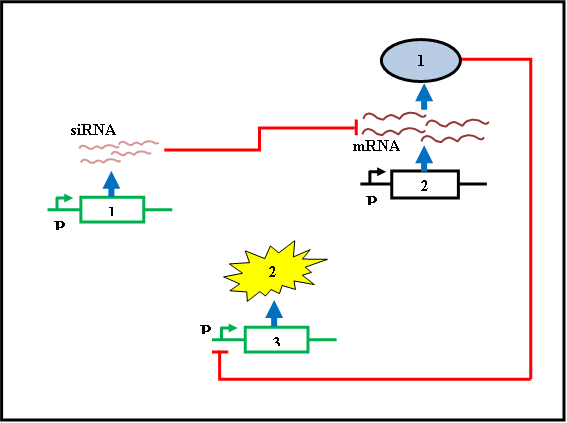
Figure 2: Genes 1 and 3 are present in the self destructive plasmid. Gene 2 is present in the cell and is always produced.
Description
Protein 1 is always produced in the cell and is controlled by the constitutive promoter on gene 2. This protein must be selected carefully since the gene 1 producing the siRNA must be decided based on this protein and the siRNA must be specific for silencing the mRNA of protein 1 without disturbing the other mRNAs of the host organism. The protein 1 will be in excess concentration and hence will inhibit the production of protein 2 (restriction enzyme or fluorescence protein) by repressing the promoter of gene 3. When the production of siRNA is induced by activating the promoter of gene 1, on reaching a threshold it will interfere with the translation of protein 1 and hence the repression of gene 3 is released to produce the protein 2.
Parameters and take into account
- Protein 1’s stability
- siRNA specificity
- Promoter strength
Biobricks
- new RBS
- new transcriptional factors with different stabilities
- new promoters with different strengths
- siRNA’s
Modeling
- Differential equations involving production rate, degradation rate (and dilution rate)
- Interaction siRNA’s - mRNA
Disadvantages in the approaches above
In the positive feedforward we anticipated that we will encounter the problem of leaky expressions of transcription factors and genes, which may cause drastic effects in an efficient delay system.
For the siRNA approach we could not find literature evidence whether siRNA works in prokaryotes. This causes a major setback in this approach for using it in our host organism E.coli. Because of these disadvantages we felt the other two approaches described as follows in below could be used.
Cascade
Based on Hooshangi et al.[4] and the project requirements, the next scheme can be proposed: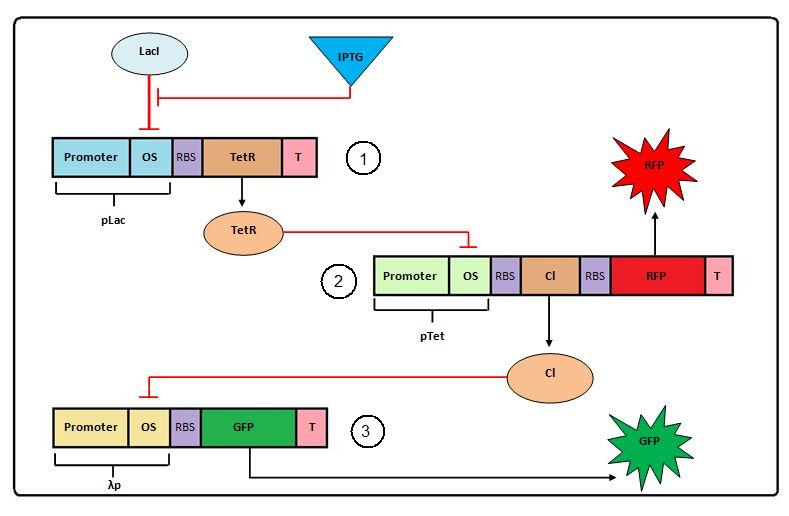
Figure 3: Gene constructs 1 and 3 are present in the cell and they are produced all the time. Gene construct 2 is in the self destructive plasmid (SDP). ![]() indicates repression.
indicates repression.
Description
IPTG starts the circuit activating (or repressing the repressor of) the promoter of TetR, for proof of concept we have used a signal molecule. The concentration of protein TetR will increase and achieve the threshold concentration to repress gene cI. At this point the production of protein cI stops. As the concentration of protein cI decreases due to its degradation, the repression of GFP gene will no longer exist and the production of GFP starts. In the final circuit it will be replaced by the restriction enzyme gene.
Parameters
In order to make a longer or shorter delay the protein production and degradation rates have to be considered. For the former, we can “play” with the ribosome binding site (RBS) and promoter strength. The degradation can be controlled by protein stability, induction of degradation and up-down regulation of degradation enzymes.
Biobricks
- new RBS
- new transcriptional factors with different stabilities
- new promoters with different strengths
Take into account
- Time frame
- Change LVA tag to decrease degradation
Modeling
Differential equations involving production rate, degradation rate (and dilution rate)
Riboregulator
In bacteria, several factors affect translation initiation, including ribosomal recognition of the mRNA’s RBS and the start codon (AUG). Recognizing the importance of RNA interactions between the ribosome and RBS, and based on work on endogenous riboregulators, Isaacs et al.[5] sought to regulate bacterial gene expression by interfering with ribosomal docking at the RBS. From the outset, their objective was to create a modular post transcriptional regulation system that could be integrated into biological networks and implemented with any promoter or gene. This system was already used by Friedland et al.[6].
Circuit 3 that we have in mind is based on the riboregulator and is shown in figure 4.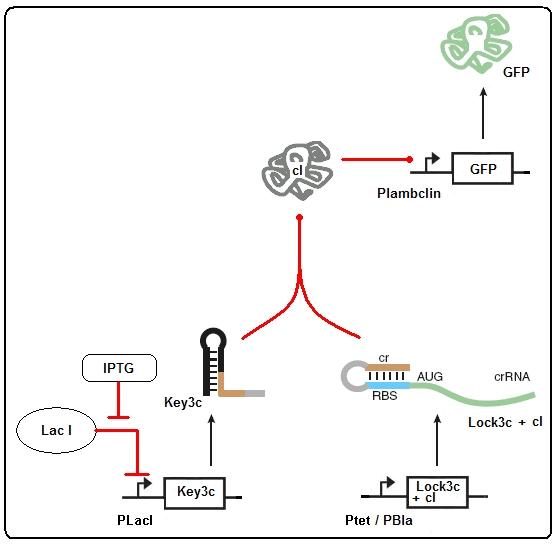
Figure 4: taRNA/RBS (riboregulator) regulated expression of GFP or Restriction endonuclease. Genes key3c, lock3c and cl are on the conjugative plasmid present in all cells. IPTG: signal molecule. GFP/Restriction endonuclease gene is present on the SDP. RBS: ribosome binding site. cr: piece of RNA strand in front of RBS that is complementary to RBS. Key3c is taRNA (trans-activating RNA), could also be small interference RNA, as long as it is complementary to cr. Product could be either GFP/luciferase (for testing) or endonuclease.
Description
Gene cl is constitutively expressed with lock3c using promoter pTet or pBla while the key3c is inducible by signal molecule IPTG (repressing the repressor LacI) using promoter pLacI. Gene cl is expressed constitutively with the crRNA, lock3c on which the cr part of the RNA binds the RBS directly after transcription, causing RBS to be blocked for the ribosome and therefore blocks the RNA from translation. When pLacI is induced by IPTG, it produces the taRNA molecule, key3c which is complementary to the cr part of the lock3c. When the key3c binds the lock3c it opens the RBS, which makes the crRNA ready for translation. The resulting product (the grey colored folded protein in figure 4) can then induce the gene to produce end-product which may be GFP or endonuclease.
Parameters and take into account
- taRNA (key3c) should be better complementary to cr (lock3c) than cr to RBS, to make sure that taRNA causes the RBS to open up
- One can play with promoter strengths for genes of key3c and end product
- The degradation rate of cl (the grey colored folded protein in figure 4) can influence the delay time
- Instead of cI inducing end-product expression, it might repress a repressor of a promoter (cascade, see figure 3), to get rid of leaky expression
- Take into account “scars”
- Time frame
Biobricks
- new RBS
- new transcriptional factors with different stabilities
- new promoters with different strengths
- crRNA for each RBS in the registry
- taRNA for each crRNA
Modeling
- Differential equations involving production rate, degradation rate (and dilution rate)
- Interaction crRNA’s – RBS and crRNA’s – taRNA’s
- Stability of taRNA’s
Combination of these approaches
These cascade and riboregulator approaches may also be combined if a large delay time is required.
Which biobricks we could use
| Part | Biobrick | Well | Plate | Plasmid | >Antibiotic | >Size (bp) |
|---|---|---|---|---|---|---|
| pLac/PLacI | R0010 | 1D | 1 | pSB1A2 | Amp | 200 |
| PBla | I14018 | 18N | 1 | pSB2K3 | Kan | 35 |
| Plambclin | I12006 | 11J | 2 | pSB2K3 | Kan | 82 |
| pTet/Ptet | R0040 | 6I | 1 | pSB1A2 | Amp | 54 |
| key3c | J23008 | 3F | 1 | J23006 | Amp | 94 |
| Lock3c | J23031 | 3L | 1 | J23006 | Amp | 42 |
| GFP | E0040 | 14K | 1 | pSB1A2 | Amp | 720 |
| mRFP1 | E1010 | 18F | 1 | pSB2K3 | Kan | 681 |
| cI | C0051 | 4E | 1 | pSB1A2 | Amp | 750 |
| RBS | B0034 | 2M | 1 | pSB1A2 | Amp | 12 |
| T (Double Terminator) | B0015 | 23L | 1 | pSB1AK3 | Amp/Kan | 127 |
| λp-RBS-GFP-T | S03335 | 85 | Box9 | pSB1A2 | Amp | 932 |
| λp-RBS-mRFP1-T | S03473 | 79 | Box9 | pSB1A2 | Amp | 918 |
| RBS - cI - RBS | K081013 | 12D | 2 | pSB1A2 | Amp | 819 |
| TetR | C0040 | 4A | 1 | pSB1A2 | Amp | 660 |
Module 2: Self Destructive Plasmid
The message that the helper plasmid caries and is delivered by the donor cell to the acceptor cell should disappear in the donor cell, after being passed to the acceptor cell. Therefore we would like to build a plasmid which is able to destruct itself. Therefore the plasmid should be able to degrade itself. This degradation should be inducible.
In order to facilitate the degradation of the plasmid we construct a plasmid whit a I-SceI endonuclease gene which is under control of a Lac promoter. This plasmid also contains several restriction sites of I-SceI in order to start degradation after inducing I-SceI transcription.
In order to construct the Self Destructive Plasmid (SDP) we build the construct showed in Figure 5 and clone it this construct into a high copy BioBrick assembly plasmid.
![]()
Figure 5: The construct to be build and cloned into a high copy BioBrick assembly plasmid.
| p-lacI | I-SceI restriction site | ||
| p-tetR | GFP with LVA tag | ||
| Constitutive promoter | TetR | ||
| Ribosomal binding site | I-SceI | ||
| Terminator |
In order to build this construct 6 other constructs should be built, assembly of these constructed will result to the above showed construct. We like to use in the first place already existing BioBricks. Since there is no I-SceI restriction site available as BioBrick, we should standardize this restriction site. The half-life time of the GFP-LVA is 40-80 minutes. This short half-life is useful for this project. After constructing the SDP we would like to induce the transcription of this GFP and stop the induction. At the time that the signal of the GFP disappears we induce the transcription endonuclease and in order to check if the plasmid is degraded we induce the transcription of the GFP once again.
Constructing the Self Destructive plasmid
Next figures will illustrate how the biobrick shown in Figure 5 will be constructed.
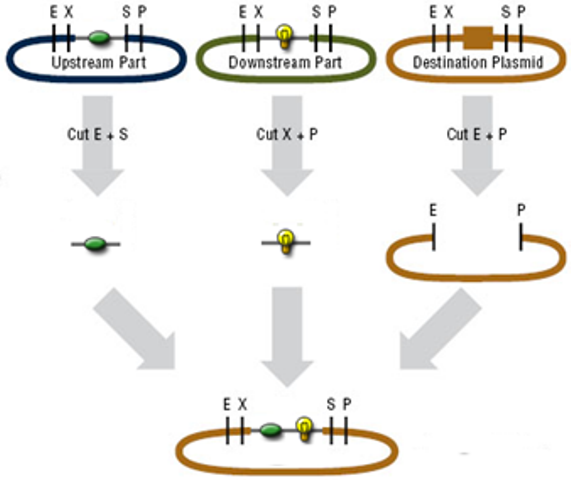
Figure 6: Assembly of GFP-LVA and ribosomal binding site.
A weak ribosomal binding site and a GFP which contains a LVA tag for rapid degradation are cloned into a high copy BioBrick assembly plasmid.

Figure 7: Assembly of GPF-LVA-ribosomal binding site with double terminator.
A double terminator is added to the GFP-LVA -ribosomal binding site construct and cloned into a high copy BioBrick assembly plasmid.
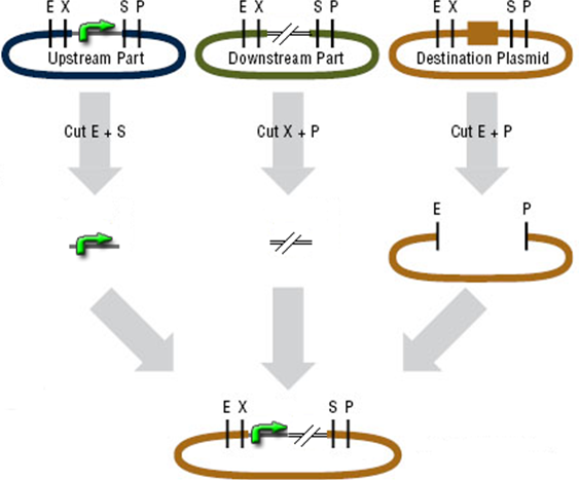
Figure 8: Assembly of tetR promoter and I-SceI restriction site.
Since the restriction site of I-SceI is not available as BioBrick, this restriction site should be standardized as BioBrick. Therefore we synthesis this restriction site flanked with the BioBrick prefix an suffix. This restriction site is than cloned into a high copy BioBrick assembly plasmid. After standardizing the restriction site this restriction site is combined with a TetR repressible promoter and cloned into a high copy BioBrick assembly plasmid. This tetR promoter will control transcription of the I-SceI endonuclease, in order to avoid constantly transcription of the I-SceI.
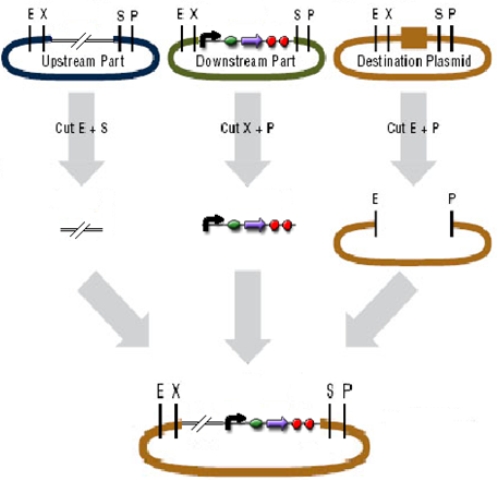
Figure 9: Assembly of I-SceI and TetR
The tetR promoter which controls the GFP-LVA transcription is repressed by TetR. Therefore the SDP should contain a tetR gene as well in order to control GFP-LVA transcription.
The I-SceI restriction site and TetR generator are cloned into a high copy BioBrick assembly plasmid.
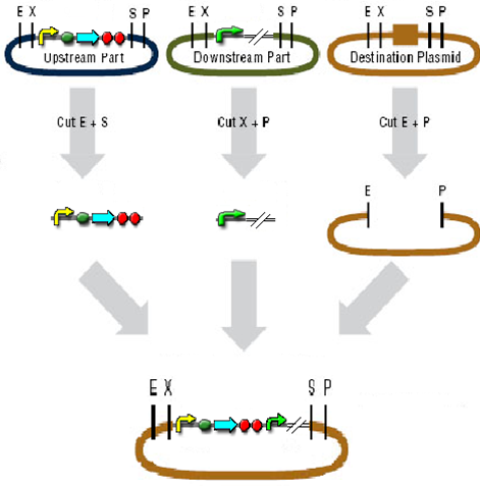
Figure 10: assembly of endonuclease, tetR promoter and I-SceI restriction site
At this point all the basic parts of the construct are built. In order to construct the SDP these parts should be reassembled. The I-SceI generator(I-Sce-I gene under control of a Lac promoter) is assembled with tetR promoter and I-SceI restriction site and cloned into a high copy BioBrick assembly plasmid.
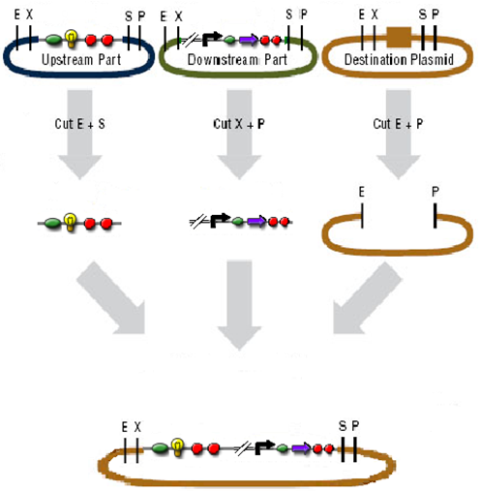
Figure 11: Assembly of GFP-LVA construct and TetR construct.
The constructs showed in figures 7 and figure 9 are assembled and cloned into a high copy BioBrick assembly plasmid.
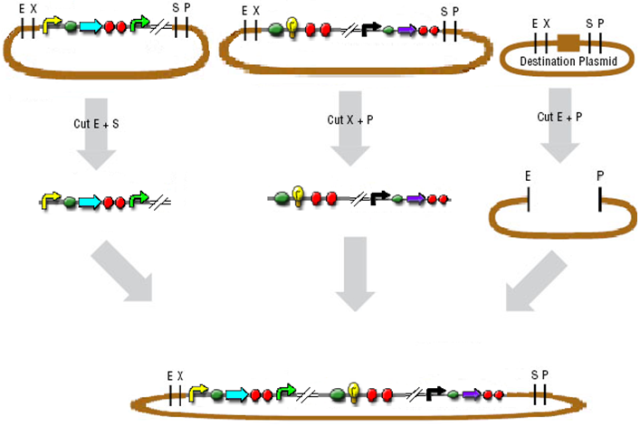
Figure 12: Final assembly of the SDP.
At this point all the constructed biobricks are assembled together in order to construct the final construct, the Self Destructive Plasmid.
Checking the Self Destructive Plasmid
In order to check the activity of SDP some experiments should be done. During the assembly of the construct several control experiments will be done. After building a construct, the construct will be checked by PCR and agarose gel electrophoresis to check the length of the construct. Verification forward primer(VF2) and verification reverse (VR) will be used. The expression and activity of I-SceI will be checked by an Assay. The construct showed in figure.10 will be used to check the expression of I-SceI. The same plasmid or other vectors containing I-SceI recognition site could be used to check the activity of the endonuclease. Incubating this plasmid with expressed and purified I-SceI and agarose gel electrophoresis will show if the endonuclease is active. These results will be compared with activity of commercial available I-SceI homing endonuclease. The expression of TetR will be checked by expression TetR from the in figure.9 showed construct. Western Blot analysis should show if TetR is expressed.
Module 3: conjugation
Selecting the Conjugation system
There are many different conjugation systems, with F and IncP being among the most used by previous iGEM teams. The IncP incompatibility group is further divided into two groups IncP-alpha aka Birmingham aka RP4 plasmid and the IncP-beta R751 plasmid. There are several reasons why the IncP system would be better suited for us:
- Smaller plasmid size (R751 is 53423[7]) (RP4 is 60099[8]) (F is 99159[9])
- F has a self-imposed fertility inhibition system (new donors fertile for only about 6 generations), IncP systems have no self-imposed fertility inhibition system[10]
- F has two surface exclusion proteins (TraT, TraS), IncP has only one (trbK)[10]
Selecting genes to knockout
Entry exclusion
The goal of this part of the project is to allow a message plasmid to be transmitted between cells containing conjugation helper plasmids (modified R751). In nature this occurs but at very low levels, due to the presence of entry exclusion proteins[11]. These membrane-bound proteins block incoming transfers from cells containing the conjugative plasmid. Note that in order for the transfer to be blocked their presence is required only in the recipient. These entry exclusion proteins are present for two primary reasons: i) to prevent redundant transfer of the conjugative plasmid among a population of cells and ii) to prevent lethal zygosis[12]. In R751 the gene trbK encodes for the entry exclusion protein in R751 and RP4[13]. Its presence is not required for conjugation to occur[14]. Some papers have reported that knocking out the trbK genes in other plasmids did not affect the conjugation frequency: “transfer of the trbK mutant occurred at near-wild-type frequencies”[15]. Given this information we propose to knockout the trbK gene.
Lethal Zygosis
What is lethal zygosis: “We find that diaminopimelic acid in the recipient membrane is released into the medium during bacterial matings, indicating that membrane damage was inflicted on the recipient by the donor, probably for forming a channel for DNA transfer. When the damage is extensive, as in matings with an excess of Hfr bacteria, the F- bacteria are killed (lethal zygosis). The transfer of a large amount of DNA in Hfr matings appears to enhance the killing"[12].
By knocking out the trbK gene we may be exposing our cells to lethal zygosis. If this is indeed the case than knocking out one of the critical mating pair formation genes (trbB, trbC, trbD, trbE, trbF, trbG, trbH, trbI, trbJ, trbL) from the trb operon would prevent this. The gene trbC was selected for this due to its small size and position on the operon. trbC is known to encode for the pilin subunits needed for pilus formation. Given this information we propose to knockout the trbC gene as well.
Experimental Procedures
Section 1: Helper Plasmid
Part 1A:
- Acquire R751 and/or RP4 plasmid
- Electoporate plasmid into cells and confirm conjugation. See [http://openwetware.org/wiki/Conjugation conjugation protocol]
- Characterize conjugation efficiency
Part 1B: oriT knockout
- Knockout oriT using either [http://openwetware.org/wiki/Recombineering/Lambda_red-mediated_gene_replacement lambda red], [http://openwetware.org/wiki/IGEM:Peking/2007/Count:Knockout knockout protocol used by Peking '07] or [http://openwetware.org/wiki/Berk2006-ConjugationTeam knockout protocol used by Berkeley '06]
- Electroporate into cells
- Verify that conjugation stopped
- Electroporate PlasmidG as well and characterize conjugation efficiency
- If works send R751 oriT knockout plasmid to registry
Part 1C: trbK knockout
- Knockout oriT + trbK
- Electroporate into cells
- Verify that conjugation takes place among R+ cells using PlasmidG (see below)
- Characterize conjugation efficiency
- If works send R751 oriT + trbK knockout plasmid to registry
Part 1D: trbC knockout
- Knockout oriT + trbK + trbC
- Electroporate into cells and create culture for communication (cultureCom)
- Verify that no conjugation takes place in presence of PlasmidG
- If works send R751 oriT + trbK + trbC knockout plasmid to registry
Section 2: Message Plasmid
Part 2A: BioBrick Assembly
- Order DNA synthesis for [http://partsregistry.org/wiki/index.php?title=Part:BBa_K175000 BBa_K175000] (trbC) and [http://partsregistry.org/wiki/index.php?title=Part:BBa_K175001 BBa_K175001] (trbK)
- Amplify BioBricks needed [http://partsregistry.org/wiki/index.php?title=Part:BBa_E0840 BBa_E0840] (GFP generator), [http://partsregistry.org/wiki/index.php?title=Part:BBa_B0034 BBa_B0034] (strong rbs), [http://partsregistry.org/wiki/index.php?title=Part:BBa_J23100 BBa_J23100] (constitutive promoter), [http://partsregistry.org/wiki/index.php?title=Part:BBa_I714031 BBa_I714031] (oriT-R).
- Assemble: [oriT][promoter] and keep this for later
- Assemble PlasmidG: [oriT][promoter][GFP generator] + plasmid backbone with different resistance than helper plasmid and low copy number.
- Assemble [oriT][promoter][rbs][trbC][rbs][trbK] and keep this intermediate assembly product for possible use in integration stage
- Assemble [oriT][promoter][rbs][trbC][rbs][trbK][GFP generator] and keep this intermediate assembly product for possible use in integration stage
- Assemble PlasmidCKG: [oriT][promoter][rbs][trbC][rbs][trbK][GFP generator] + plasmid backbone with different resistance than helper plasmid and low copy number.
Part 2B: Full Communication testing
- Electroporate PlasmidCKG into some cells from cultureCom creating initiatorCells
- Select for presence of both message and helper plasmid
- Mix initiatorCells with cells not containing any plasmids and characterize conjugation efficiency
- Add initiatorCells to cultureCom and observe signal propagation, characterize rate of signal propagation.
- If signal propagation observed, do victory dance.
References
- Smolke C, 2009. [http://www.ncbi.nlm.nih.gov/pubmed/19478174 It’s the DNA That Counts]. Science, 324:1156-1157.
- An introduction to systems biology: design principles of biological circuits. Uri Alon, Publisher CRC Press, 2006, pp 41-69.[http://en.wikipedia.org/wiki/Special:BookSources/1584886420 ISBN 1584886420]
- Elbashir SM, Harborth J, Lendeckel W, Yalcin A, Weber K, Tuschl T., 2001. [http://www.ncbi.nlm.nih.gov/pubmed/11373684 Duplexes of 21-nucleotide RNAs mediate RNA interference in cultured mammalian cells]. Nature, 411(6836):494-498.
- Hooshangi S, Thiberge S, Weiss R, 2005. [http://www.ncbi.nlm.nih.gov/pubmed/15738412 Ultrasensitivity and noise propagation in a synthetic transcriptional cascade]. PNAS, 102,10 :3581–3586.
- Isaacs F, Dwyer d and Collins J, 2006. [http://www.ncbi.nlm.nih.gov/pubmed/16680139 RNA synthetic biology]. Nature Biotech., 24:545-554.
- Friedland A, Lu T, Wang X, Shi D, Church G and Collins J, 2009. [http://www.ncbi.nlm.nih.gov/pubmed/19478183 Synthetic Gene Networks That Count]. Science, 324:1199-1202.
- Thorsted, P. B., D. P. Macartney, P. Akhtar, A. S. Haines, N. Ali, P. Davidson, T. Stafford, M. J. Pocklington, W. Pansegrau, B. M. Wilkins, E. Lanka, and C. M. Thomas. 1998. [http://www.ncbi.nlm.nih.gov/nuccore/113911681?ordinalpos=1&itool=EntrezSystem2.PEntrez.Sequence.Sequence_ResultsPanel.Sequence_RVDocSum Complete sequence of the IncPbeta plasmid R751: implications for evolution and organisation of the IncP backbone]. J. Mol. Biol. 282:969-990.
- Pansegrau, W., E. Lanka, P. T. Barth, D. H. Figurski, D. G. Guiney, D. Haas, D. R. Helinski, H. Schwab, V. A. Stanisich, and C. M. Thomas. 1995. [http://www.ncbi.nlm.nih.gov/nuccore/508311?ordinalpos=1&itool=EntrezSystem2.PEntrez.Sequence.Sequence_ResultsPanel.Sequence_RVDocSum Complete nucleotide sequence of Birmingham IncP alpha plasmids]. Compilation and comparative analysis. J. Mol. Biol. 239:623-663.
- Frost, L., K. Ippen-Ihler, and M. Skurray. 1995. [http://www.ncbi.nlm.nih.gov/nuccore/9507713?ordinalpos=1&itool=EntrezSystem2.PEntrez.Sequence.Sequence_ResultsPanel.Sequence_RVDocSum Analysis of the sequence and gene products of the transfer region of the F sex factor]. Microbiol. Rev. 58:162-210.
- Plasmid Biology. Barbara E. Funnell and Gregory J. Phillips, eds. American Society for Microbiology Press, Washington, DC, 2004. Chapter 9.[http://en.wikipedia.org/wiki/Special:BookSources/1555812651 ISBN 1555812651]
- Garcillán-Barcia MP, de la Cruz F. [http://www.ncbi.nlm.nih.gov/pubmed/18440635 Why is entry exclusion an essential feature of conjugative plasmids?] 2008;60:1–18. doi: 10.1016/j.plasmid.2008.03.002.
- Ou, J. T. 1980. [http://www.ncbi.nlm.nih.gov/pubmed/6993854 Role of surface exclusion genes in lethal zygosis in Escherichia coli K12 mating]. Molecular and General Genetics 178:573–581.
- Haase, J., Kalkum, M. & Lanka, E., 1996. [http://www.ncbi.nlm.nih.gov/pubmed/8955288 TrbK, a small cytoplasmic membrane lipoprotein, functions in entry exclusion of the IncP alpha plasmid RP4]. J. Bacteriol. 178, 6720–6729.
- Haase J, Lurz R, Grahn A M, Bamford D H, Lanka E., 1995. [http://www.ncbi.nlm.nih.gov/pubmed/7642506 Bacterial conjugation mediated by plasmid RP4: RSF1010 mobilization, donor-specific phage propagation, and pilus production require the same Tra2 core components of a proposed DNA transport complex]. J Bacteriol. 177:4779–4791.
- Li, P. L., Hwang, I., Miyagi, H., True, H., Farrand, S. K., 1999. [http://www.ncbi.nlm.nih.gov/pubmed/10438776 Essential components of the Ti plasmid trb system, a type IV macromolecular transporter]. J. Bacteriol. 181:5033-5041.
 "
"